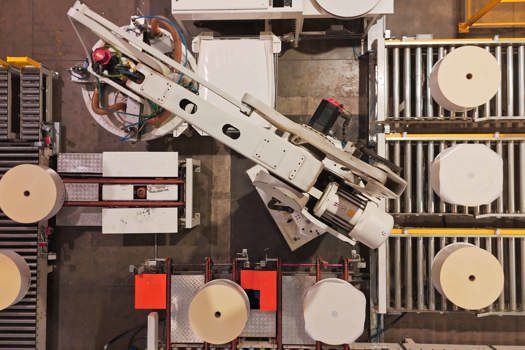University printers are now being faced with two choices: close and let the colleges outsource, or re-invest in operations to provide a full service. Imprint & Design chose the latter. The manufacturing site was originally split in two, just 300 yards apart, within the grounds of Bradford University and College. But following the HEFCE guideline change, the operations were reviewed, found to be fundamentally doing the same thing, and merged as a limited company.
Led by the university’s print manager, Brian Pickles, the firm originally focused on work for the colleges, before branching out to fill capacity. Pickles says: “There were peaks and troughs in our workload – such is the nature of educational print – and realised outside work would utilise our resources more efficiently.”
To this end, Imprint began to take on ‘outside’ work, including jobs for other colleges. Five years later, the firm owes around £300,000 of its £2m annual turnover to commercial jobs outside the education sector.
Key to Imprint’s future, however, is finding a way to combine the resources of educational institutions across West Yorkshire. “We want to become an educational printing hub,” Pickles explains. “If institutions keep out-sourcing their print, then the money is not staying in the education system. But if other universities invested in us, the money stays in one pot and can then be re-invested in the higher education system.”
As a member of the University Print Managers’ Group, Pickles hopes his firm can lead the way in educational printing. “If we limit outsourcing and pool resources, it could be a model of good practice for other areas to follow.”
To limit its outsourcing, which last year represented £500,000 of invoices, Imprint has invested in a Presstek 34DI press. “It is very rare for universities to spend money on litho equipment, as a large percentage of the work produced is digital, but we believe that by minimising outsourced litho work we can recover our initial investment within three years.”
Other initiatives to add revenue to the firm include an onsite shop called Copyzone at Bradford University’s newly-built Atrium. Students, teachers and external customers are able to print digital copies as well as dissertation printing and binding.
Strong knowledge of the educational sector has played some role in winning external work for Imprint. “We are used to receiving jobs in any number of formats, which are often not good enough to go straight to print. We offer help and advice, and have graphic designers who can convert and work on the jobs that come in,” explains Pickles. “Unlike other printers, we don’t charge for this service – you only pay for the printed work – and that’s where I believe we have an advantage.”
Pickles insists, however, that Imprint is not competing with commercial printers. “Six small- to medium-size commercial printers have closed in the past few years in this area,” he says. “It makes no sense to force our way into the market.”
With income from monochrome digital (once the heart of educational print) declining rapidly, exploring new areas is the only way to stay profitable without out-sourcing. “The market is evolving, and new investments and the sharing of services are just some of the ways we hope to evolve with it,” says Pickles.
IMPRINT & DESIGN
Formed In 2002 when the in-house print facilities of Bradford College and Bradford University combined
Location Bradford, West Yorkshire
Turnover £2m
Staff 21
Kit Presstek 34DI, Xerox monochrome and colour digital B3 presses, Epson wide-format inkjet; range of finishing machines
Sectors Digital, litho, design and print buying
Learned ways to reduce duplication
The Higher Education Funding Council for England (HEFCE) is redefining its guidelines in an effort to pool together the resources of universities and colleges and minimise any duplication of costs. As a result, print sourcing by higher education bodies, traditionally done in-house, is changing dramatically.








